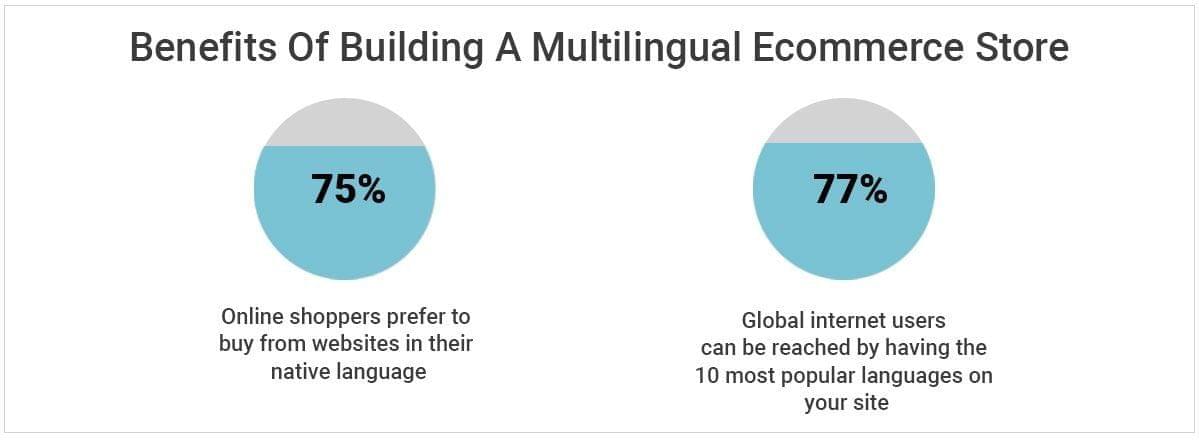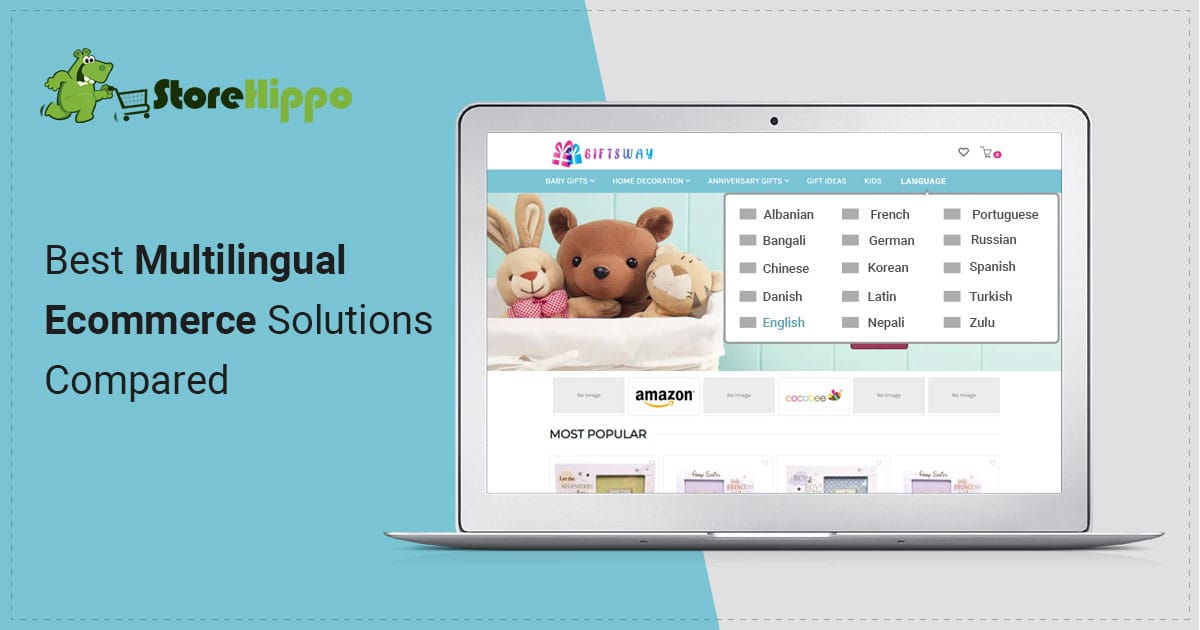All set to expand your business? Planning to tap new international and domestic markets? Want to give a winning edge to your business by making a multilingual ecommerce store?
Congratulations!
You have made the best decision for your business with far-reaching impacts. This singular change to your website will be paying you rich dividends in more than one way.
Want to explore how?
Table of Contents
Benefits Of Building A Multilingual Ecommerce Store
Going for an online store in multiple languages gives you a unique competitive advantage. Did you know that;
- 75% of online shoppers prefer to buy from websites in their native language
- 77% of global internet users can be reached by having the 10 most popular languages on your site

Need more reasons to be happy and positive about your decision to add multiple languages on your website?
Here are the many advantages of adding more than one language to your ecommerce portal:
- Connect better with your customers by selling your products or services in the language they understand the best
- Make your content powerful by adding language-specific nuances like and practices like date and time pattern, punctuation, capitalization etc.
- Improve conversions by targeting specific user segments based on geo locations.
- Get better SEO optimization Google rankings by targeting language-specific keywords for each language you have on your online store.
- Reach new markets by adding languages that are spoken in non-English speaking growing ecommerce markets. For example, The Middle East.
- Implement cost-effective marketingwith amultilingual ecommerce store and personalised deals that make you a customer-centric brand.
- Sell more by adding more languages. Customers are 3x more willing to buy new products or services sold in their native language.
- Beat the cut-throat competition by just connecting better in customers’ native language rather than burning holes in your pockets by offering numerous discounts.
Why You Need An Multilingual Ecommerce Platform
Once you decide to add multiple languages to your website, the next step is to either go for a custom solution or opt for turnkey multilingual platforms. While going for custom-built software is time taking and resource-intensive, the readymade solutions give you the following advantages:
- Quick to implement as there is a readymade solution for a variety of businesses
- Tested and bug-free solution that eliminates the testing time
- Easy to start small and go an adding as many languages as you wish
- Automated solution that makes it easier to add multilingual details to your products and categories
- A cost-effective solution that does not need an IT-team add languages to your site
5 Best Enterprise Ecommerce Software For Large Businesses
Now that it is clear that turnkey solutions are a clear winner, let us check out the top 5 multilingual ecommerce platforms to take your business to international markets:
1. StoreHippo
StoreHippo offers an inbuilt multilingual ecommerce solution that helps in adding many languages to an ecommerce site. The solution is designed to offer ease of use so even a novice person can easily add desired languages from the admin dashboard.
StoreHippo does not use any apps to give you multilingual support in themes and static content. This keeps your site fast and allows you to implement multiple languages without compromising your site-speed.
With StoreHippo you can add 100+ languages to your ecommerce store. With hassle-free automatic translation, you can add new languages within a few clicks. You also get complete translation control and can decide where to use automatic translation and where to override it with manual translation.
Along with this you can set up rules to auto-detect language based on customer IP or set different languages for different domains. You can also do bulk translations with CSV and Excel files to save time. You can easily translate core entities like Products, Categories, Collections, Brands etc. in multiple languages using easy bulk translations through CSV.
StoreHippo multilingual ecommerce solution also gives you the advantage of adding multiple languages to your mobile apps. It also offers inbuilt support for RTL languages like Arabic, Hebrew, Urdu, Persian etc. The RTL support is extended to RTL compliant themes where you can customize action buttons in any of the right to left languages.
StoreHippo also offers full support for multilingual in multiple storefronts, wherein you can dedicate a store to a given language. Along with these, you can also convert your store messages(error, warning, deals etc.) in any preferred language including RTL languages.
Another added advantage is the option to go for paid customizations and turn your admin dashboard into multiple languages. You can also customize your seller panel in a multi vendor marketplace set up by adding the languages preferred by your sellers and distributors.
However, you get these features only with Premium, Business and Enterprise plans. You will also have to pay additionally for customizations needed to convert your admin panel into multiple languages.
2. Shopify
Shopify offers the multilingual ecommerce feature using multiple apps or plugins. Shopify rolled out a native beta version of multilingual at the end of 2018, which is still very limited in scope as it only allows the admin to change the language on the site. The customers cannot change the language as per their preference.
Alternatively, Shopify offers many apps to implement multiple languages at various levels in your store. Some of these apps are designed for automatic translation functionalities while the others offer automatic translation. On average, you might need 5-6 multilingual apps to implement themes and checkout language change and build a fully-functional multilingual ecommerce store with Shopify.
Shopify users complain that adding multiple apps slows their site speed. Also, it is quite a task to sync various apps made by third parties. The subscription cost also goes up as one has to keep adding more apps for themes, cart, invoice etc.
Shopify multilingual ecommerce does not support RTL languages in themes and you would need detailed customizations by an expert to get it implemented. You need to watch out your budget while adding multiple languages to your Shopify store using a host of apps as the prices may snowball rapidly.
3. Magento
Magento offers a multilingual ecommerce platform wherein you can implement a variety of languages on your site with the relevant extension for each language. Just like Shopify, you would need multiple extensions and plugins to build a truly multi-language site.
For each of the new languages, you need to create a new store view in Magento 2.0. There are multiple steps involved in adding languages and changing product information in multiple languages manually. One can also choose from paid extensions to automate the process.
However, despite offering a good multilingual ecommerce solution, you would need expert developers to make your website truly multilingual. Magneto has a strong developer community which helps with changes but the whole process is time-consuming.
Adding too many extensions also makes the site slow and buggy. Also, you need to pay for each of these extensions and plugins which can be quite a balancing act if you are on a budget and still need to have multiple languages on your store.
Since Magento upgrades every few years, you might need not only a migration but additional extensions while replatforming which could be as effort intensive as building a new multilingual ecommerce site.
4. BigCommerce
BigCommerce does not offer a native multilingual ecommerce solution but you can implement it through changes in code. You need to create multiple stores to implement different languages in each store.
Some of the BigCommerce users complain that the multilingual functionality is only partially implemented and needs an expert developer to customize and make a fully multilingual store.
This makes it difficult for a non-developer to make these changes and inevitably you will have to hire a developer to handle your online multilingual ecommerce store built on BigCommerce.
5. WooCommerce
Just like the other platforms, except StoreHippo, WooCommerce also offers plugin-based solutions to implement multiple languages on your site. There are many free as well as premium plugins that help you turn a regular store into a multilingual ecommerce site.
However, with the free plugins you only get limited functionality and you will need to hire professional help to do the translations manually for you. The paid plugins have a premium cost and they automate the translation process. Howeverver, translation capability is limited to 40-something languages.
Another issue is that these plugins slow the site speed. Also, you might need to add more than one extension or plugin to achieve the desired level of functionality in multiple languages. Also, some of the customers have reported that implementing RTL in WooCommerce themes is very difficult. You might need to get in touch with the dev team of the multilingual ecommerce solution provider who have made the plugin you are using. This complicates and slows the overall development.
How To Choose The Best Multilingual Ecommerce Platform For Your Business
Going to international markets helps you grow your business rapidly. However, to make the best of this opportunity you will need to have the best multilingual ecommerce platform that helps you connect with your customers. Also, it should be a hassle-free solution that lets you focus on growth rather than keeping you busy in managing multiple languages.
To help you make the informed decision about turning your online store into a multilingual site, we have presented the most comprehensive set of features, pros and cons of each of the platforms. However, along with these features, do explore other ecommerce features that might help you grow your business by making selling easier.
Ready to explore various multiligual ecommerce solution providers? Start from StoreHippo by booking your free-demo now!


